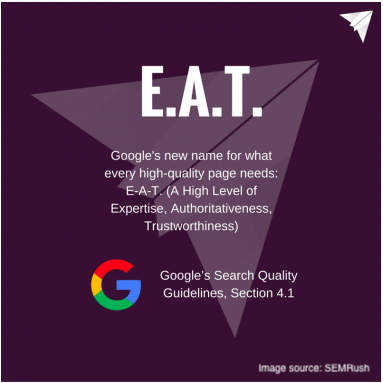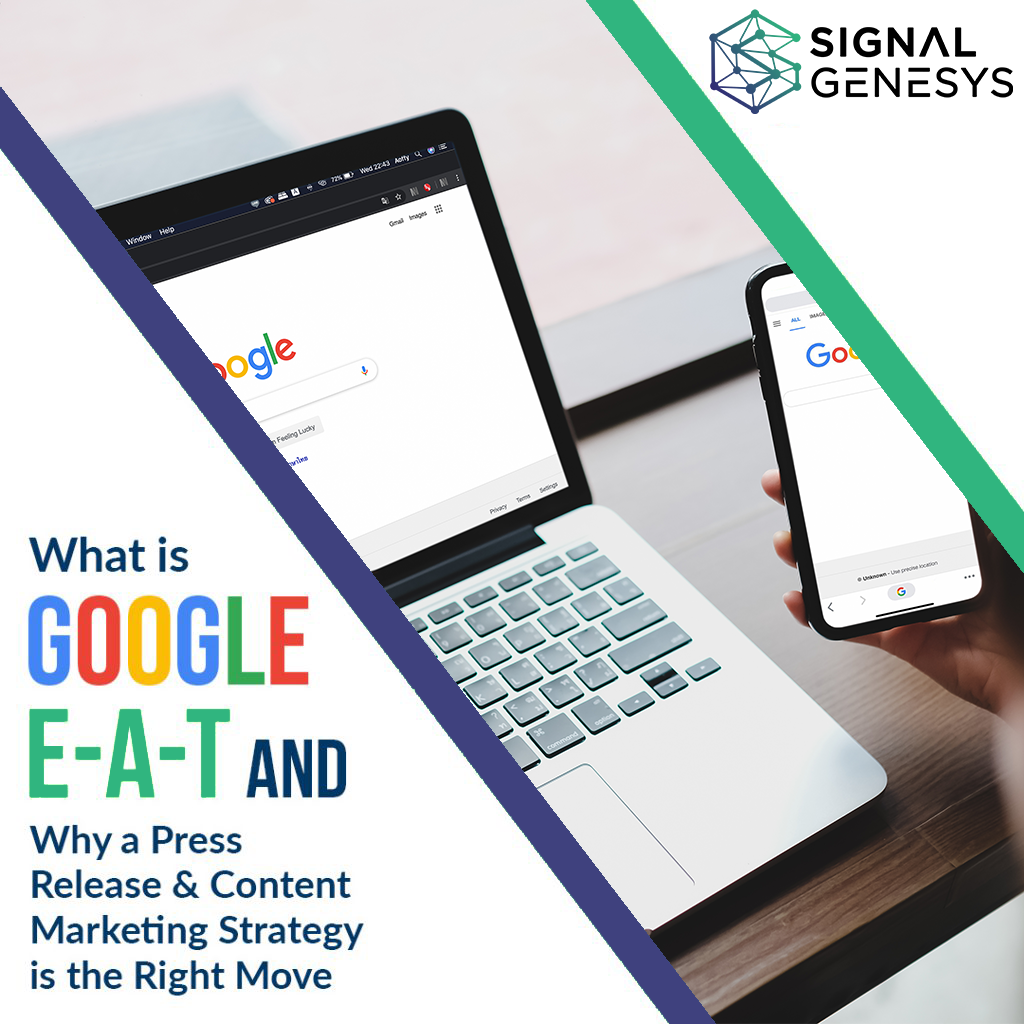Google E-A-T Guidelines Are Important to Understand
If you haven’t heard of Google E-A-T or Google’s quality guidelines before you need to take a few minutes and get up to speed with this. It’s not new per se but I still find a lot of agency owners who haven’t really come across this very important component of Google’s algorithm.
What does Google E-A-T Stand For?
Google E-A-T stands for Expertise, Authoritativeness, and Trustworthiness and these three elements are measured on every page googlebot crawls and renders. There are direct quality rater guidelines (Google EAT Guidelines) for manual/human page analysts that are assigned pages to “rate” for quality.
What are the elements to demonstrate quality? Simply put.
- Expertise,
- Authority, and
- Trust
So when you write a piece of content for your own agency, or for a client’s SEO campaign, you want to purposefully and intentionally structure your content in a way that “demonstrates expertise” on the relevant topic (target keywords), positions the author as an “authority” on the topic and creates and builds trust for the reader that the content is reliable and “trustworthy” (think connecting to related authorities and citing other experts or SMEs on the relevant topic in your article).

Google Quality Raters have 3 main tasks for each page they are tasked with rating:
- Judging the quality of web pages,
- Making sure mobile results are helpful, and
- Checking whether queries in general show quality results.
The “quality” of a page is further broken down by evaluating for E-A-T.
Google E-A-T has it Roots in Authorship
Keep in mind that the “author” of the article should be connected to the entity that you are trying to rank for the relevant topic and keywords. The author can be the entity, but ideally, that content should be setup with “authorship” in mind because Google E-A-T has it roots in authorship.
Here’s why I say that… this is directly from the Google Quality Rater Guidelines in section 2.5.2:
“Every page belongs to a website and it should be clear:
- Who is responsible for that website
- Who is responsible for the content you are evaluating on that page”
Click the link above to read this section of the QRG or Quality Rater Guidelines but this sums that entire section up… the rater is to evaluate “WHO” is responsible for the content. That is authorship.
Next, the rater is tasked with evaluating the level of expertise, authority and trustworthiness of the content and Google gives the rater much instruction on “how” to evaluate these elements.
Now, here’s the important lesson… all of these elements and data points are built into the E-A-T components of the algorithm (many components, not just one) and Googlebot is extremely accurate in evaluating this automatically without the need for human intervention. These entity signals are what Gbot looks for in every page it crawls and every page Googlebot crawls is evaluated for EAT and a best effort made to identify “who” is responsible for the content.
Understanding the YMYL Component
According to the Google Quality Rater Guide, YMYL topics include:
- medical advice
- the financial sector
- news and current events
- civics and government
- shopping
- groups of people
YMYL stands for your money, your life. These types of topics have a much larger impact on one’s life and thus Google places a much higher expectation of demonstrating E-A-T on these types of sites and the pages on these sites.
To put Google E-A-T in practical terms, an authoritative, trustworthy website that demonstrates expertise on the subject matter should:
- Have content written by experts with a deep understanding of the given topic.
- Demonstrate the expertise of all contributing authors within the content.
- Be a reliable source of information trusted by other reputable sources in the same field.
Below are 14 tips on how to structure and build your articles to best position the content for demonstrating E-A-T. We follow this SOP on all articles we write as a white label solutions company and recommend all agencies develop an SOP like this if you handle the authorship of content for you and your client campaigns.
14 Expert Tips for Optimizing Your Articles to Demonstrate Expertise, Authority and Trust
See my video tutorial here where you can watch me optimize an article inside Signal Genesys using these tips : https://youtu.be/-U3jGrG0NI4
14 Tips to Satisfy Google E-A-T Guidelines
- Research! Get it right. See the tools list below that I use for my research. 90% of your result of anything in SEO comes from the first 10% of the process. In SEO, the first 10% is your research. Don’t shortcut this step. Personally, I use Keywords Everywhere and their Chrome extension for a big part of the keyword research along with SEMRush.
- 1-2 target keywords at most per article (GMB business categories are keywords). Don’t try to create an article of content that addresses more than one topic. That “topical theme” should have 1-2 target keywords at most and then see the next point.
- Include semantically related keywords in your content. Semantically related keywords are just that, keywords related to the topic or the target keywords. There are great tools like SEMRush that evaluate all page one content for a targeted keyword and then provides you a list of the common keywords that occur on all pages that are ranking. This is part of my/our research in step one and I use SEMR for this but there are other tools as well.
- Use H2-H3-H4 section headings to breakup and “section-ize” your content. Google loves section headings and relevant content/answers to the section heading below.
- Even better, use the People Also Ask (PAA) or the People Also Search For questions from the target keyword in search as your section headings! Keywords Everywhere has a great feature for this as well which is another reason I love their tool. Another great tool is Answer the Public that you should check out for more intelligence on what people are asking online.
- Answer the question in the paragraph content below the section headings. It’s a simple, logical step but bears being emphasized. Google will crawl your article, find the section heading and then look for relevancy in the content below the H-tag. Feed Google what it wants!
- Make your first link a do follow link to your target GMB or web page you want to rank, always. The first link in your content is the most important, we use the first link in a couple different ways to send links to: GMB CID and PID link, service pages, location pages, previous press release article URLs for a PR stacking strategy.
- Make your last link in the article a do follow to the previous relevant article/press release in your media room or one of the above referenced examples if you use the first link to a previous press release article URL from your media room.
- Quote or cite sources of information and provide links to them. All links in between the first and last links in your article should be no follows and you should have several! Give the reader (and googlebot) other authority links to topically relevant content/pages. Link to them with optimized anchor text and make sure they are marked as no follow. There is no reason to send do follow authority or juice to another authority in the space. The more the merrier in this point really. Google loves rich content that gives the reader lots of connecting points to demonstrate that the content is on point and trustworthy. Use no follow links to make “relevant connections” between your content and authority pages for the same topic and target keywords. Make sure to set these links to no follow and to open up in a new tab so you don’t bounce the reader off the target page.
- Include images in your article from a related/relevant GMB post (has to be a GMB post image) if you are doing local/map pack SEO to generate GMB image signals inside the content and to create another connection between the content and the target GMB listing. Google loves images so don’t be shy! Use them but use them strategically by pulling in images from source URLs from your GMB listing and/or your target website.
- Include YouTube videos about the company or its services/products if you can. We all know both readers/users and Google love video so feed relevant content in the form of videos from a related YouTube channel for the target entity. Use YouTube as another Google asset in your Google Entity Stack for the video components of your content. Let’s be honest, that will be better than using the same video from a Vimeo account, for example.
- Add city names and zip codes into your content for local relevance and proximity signals. Zip codes as hashtags can work too. Whatever you do, try to train Googlebot by sending localized signals in the form of zip codes, cities, neighborhoods and local points of interest into your content and even link to them with no follows when it can apply like in the case of points of interest.
- Make sure images are no wider than 550px inside the body of articles if they are going out for distribution to the media sites and this is just good practice for all content marketing. Large images load slower and may not fit on sites your content is syndicated to, especially if you use Signal Genesys to syndicate the content to the media room as a press release for pick up and publication on live news, media and radio station sites.
- When writing and structuring your content, think in terms of SIGNALS. How many different ways can you give Googlebot a signal in your content?
- Content syndication is a really effective method to generate more signals around any given piece of content. This is one of the core strategies we execute on with Signal Genesys and our new app channel releases with GMB, Reddit, Twitter and Facebook coming soon, the syndication of content continues to have more distribution end-points while the amount of signals generated continues to increase and broaden.
- Link signals (do follows and no follows are signals but only do follow links pass real pagerank/authority.) Links are connections. Links train Googlebot so use them to provide cites, resources and depth to your content.
- GMB signals (links to the GMB using the CID, PID, EID and share links, vary it; GMB post image signals, links to GMB posts or GMB business.site; links to Google reviews with an image from a GMB post which is an image of a review)
- On-Page signals (H-tags, structured sections with PAA, images, videos, audio/podcasts, reviews with links to the reviews, target keyword density, LSI/semantically related keyword usage)
- Local signals (usage of city names, zip codes, neighborhoods in content; links to local authorities and POIs like museums, parks, government sites, etc.)
Ultimately, a high Google E-A-T rating is given to pages that are able to demonstrate the following:
- They cite their sources,
- The page includes author bios and credentials,
- The page has authors that are experts in the given field (or links to them), and
- The company of the target website and the author of the content have a good reputation and reviews.
Research and Writing Tools I Use:
- SEMR – https://semrush.com
- Google search with Keywords Everywhere extension
- GMB Crush Chrome extension
- PlePer Chrome extension
- Page Optimizer Pro or Surfer SEO
- Google Docs with SEMR add-on writing assistant
Here is a 3-Part Case Study Video Series Blueprint on How I Got Page ONE and #1 Spot Rankings in Less Than 70 Days
- Part One – https://youtu.be/qheKiqefaZg
- Part Two – https://youtu.be/3D1i6VtH8KE
- Part Three – https://youtu.be/HPSi7h181CI



